Corrosion of metals used in construction is an age-old problem, one with annual costs exceeding $300 billion today in the United States alone. In addition to economic losses, corrosion of structural and non-structural elements creates a significant safety risk, particularly with critical connections. Fortunately, technologies have been developed to help address many of the causes of corrosion of these connections with effective products and processes.

The type and extent of corrosion are often a function of the environment. Wet environments in the presence of conductive fluid (i.e., humidity) can attack the surface of the connection elements (base steel, connected material, and accessories such as nuts and washers), thus causing surface or pitting corrosion. A steel base material could be carefully coated with a protective coating, only to have that coating destroyed when a connection is made. For example, effective welding to the steel may require removing the coating, or the welding process itself may destroy the coating. Connection methods like through-bolting can cause another form of corrosion called galvanic corrosion when dissimilar metals are in contact with each other in the presence of a conductive fluid. It should be noted that welding and drilling can damage the coating both on the connection side of the steel and the opposite side of the steel (Figure 1).
Where load transfer requirements are high, welding of the steel members may be the only feasible solution. Quality controls should be specified to ensure that coatings and welds are properly repaired and re-coated. In many applications, non-welded solutions may be appropriate. For example, when framing supplemental steel to primary steel, bolting may be indicated. However, in a corrosive environment, the potential for galvanic corrosion or crevice corrosion may exist. Additionally, unless the hole locations are planned and pre-punched in the shop, the process can be laborious and expensive. Similarly, the attachment of modular systems (“strut” systems) can be accomplished by through-bolting or clamping. However, the clamping devices may not always be effective, depending on the steel shape that is being clamped to, like tube members, for example.
As a structural engineer, you may be called on to design or evaluate critical non-structural connections, such as hangers for utilities and equipment or fastening bar grating to steel on a mezzanine. Traditionally, these connections are accomplished with welding, through-bolting, or clamping. However, as outlined above, these solutions can invite corrosion. Additionally, they may not be feasible in the field if the base steel is too thick to drill or the backside cannot be accessed to complete the connection. Fortunately, technologies have recently been developed which address corrosion concerns and provide a practical means for installation. Key features of these products include highly corrosion-resistant materials, the ability to complete the fastening without accessing the steel backside, and minimal disturbance of the base material coating.

One example features a fastener that is driven into a small pre-drilled hole in the steel. Forming the hole is accomplished by a special stepped drill bit that does not penetrate through the base steel; simultaneously, the bit removes a small circle of coating or surface rust to prepare for the fastening. The blunt-tipped stainless steel fastener is driven into the hole using a battery-actuated tool. The act of driving the fastener point into the hole displaces some of the base steel, which is then melted by the friction heat, creating a micro weld. The result is a threaded stud protrusion from the steel, carrying a working load up to 800 pounds in tension and up to 850 pounds in shear. Below the threaded portion, tight against the steel surface, is an integrated stainless steel washer with a neoprene washer bonded to it, which seals and protects the uncoated steel surface and prevents water infiltration. Even though the stud material and the base steel may be dissimilar, the prevention of water infiltration helps prevent galvanic corrosion (Figure 2).
Also available is a system meeting similar requirements, which can be installed without a battery-actuated drive tool. A hole is drilled with a similar stepped drill bit, which provides the precise drilling depth and removes a small circle of the existing coating. The blunt tip of this fastener features high-strength threads. When the fastener is driven (screwed) into the pre-drilled hole, it cuts fine threads in the base steel. Like the system described above, the threaded stud protrusion includes a sealing washer, which protects the steel and prevents water infiltration. Working loads for this fastener can be up to 600 pounds. Both systems described above provide a ¼-inch or 3⁄8-inch threaded protrusion that can be used to attach a baseplate or strut profile or hang a pipe or equipment using a coupler and a threaded rod.
As long as connections need to be accomplished on construction projects, corrosion will continue to cause concern. Manufacturers will continue to advance the state-of-the-art by developing safer and more practical technologies to address these concerns.■
